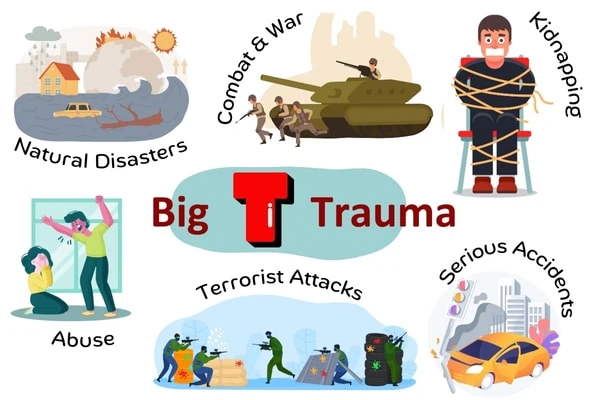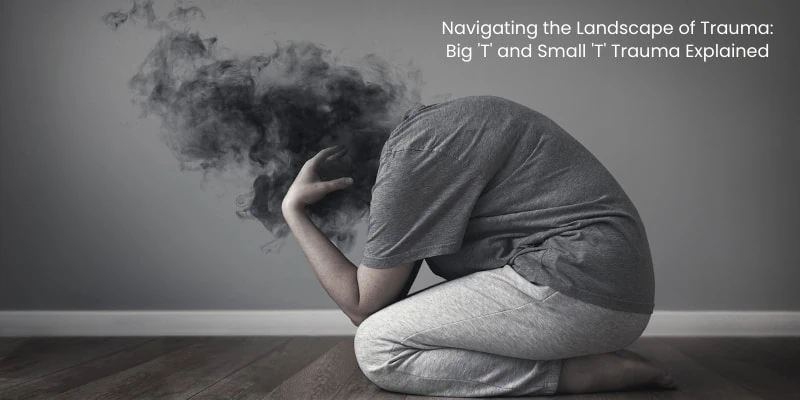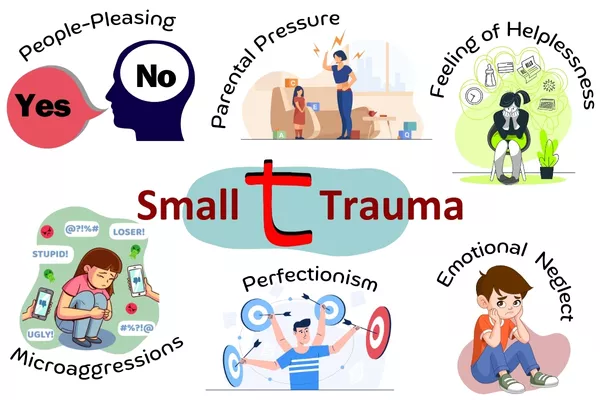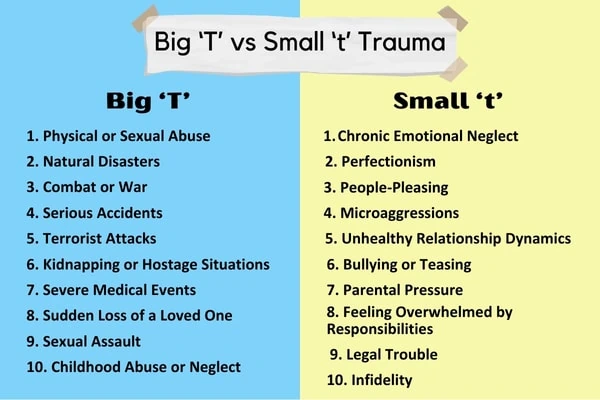Trauma is a powerful word that often brings to mind catastrophic events or severe experiences that leave lasting scars.
However, it’s essential to recognize that trauma comes in different shapes and sizes. In the realm of psychological distress, we often distinguish between big ‘T’ trauma and small ‘t’ trauma, acknowledging that both can significantly impact an individual’s mental and emotional well-being.
Big ‘T’ Trauma:

Big ‘T’ trauma refers to the more widely recognized and extreme events that can cause severe psychological distress. A few examples of big ‘T’ trauma include
– Physical or Sexual Abuse: Any form of physical or sexual assault, whether it occurs during childhood or adulthood, is a major traumatic event that can have lasting psychological effects.
– Natural Disasters: Experiencing a catastrophic event such as earthquakes, hurricanes, floods, or wildfires can lead to big ‘T’ trauma. The sudden loss, destruction, and fear associated with these events can leave lasting emotional scars.
– Combat or War: Military personnel who have been in combat situations may experience big ‘T’ trauma. Exposure to violence, loss of comrades, and the constant threat to one’s life can lead to conditions like PTSD.
– Serious Accidents: Being involved in a severe car crash, plane crash, or any other life-threatening accident can result in big ‘T’ trauma. The physical and emotional impact of such events can be long-lasting.
– Terrorist Attacks: Witnessing or directly experiencing acts of terrorism, such as bombings or mass shootings, can be profoundly traumatic, causing lasting psychological distress.
– Kidnapping or Hostage Situations: Being kidnapped or held hostage involves a significant threat to one’s life and safety, often resulting in big ‘T’ trauma.
– Severe Medical Events: Facing life-threatening illnesses, undergoing major surgeries, or experiencing a significant medical crisis can be traumatic. The fear of death and the physical impact can contribute to lasting psychological distress.
– Sudden Loss of a Loved One: The sudden and unexpected death of a close family member or friend, especially through accidents, homicide, or suicide, can lead to big ‘T’ trauma.
– Sexual Assault: Experiencing any form of sexual violence, including rape or sexual assault, is a significant psychological and emotional trauma that can have lasting effects.
– Childhood Abuse or Neglect: Enduring physical, emotional, or sexual abuse during childhood, as well as chronic neglect, can result in big ‘T’ trauma. These experiences can shape the individual’s psychological development and impact their adult relationships.
Big ‘T’ traumas often result in intense emotional reactions and can lead to conditions like Post-Traumatic Stress Disorder (PTSD). Big ‘T’ trauma events are typically life-threatening, and the impact is so profound that it can reshape a person’s entire worldview. The effects of big ‘T’ trauma can be pervasive, influencing not only the individual’s mental health but also their relationships, daily functioning, and overall quality of life.
Small ‘T’ Trauma:
On the other hand, small ‘T’ trauma refers to the more subtle and frequently overlooked stressors that can accumulate over time, gradually eroding a person’s sense of safety and well-being. Some examples will look like:
– Chronic Emotional Neglect: Growing up in an environment where emotional needs are consistently unmet can be a form of small ‘T’ trauma. This might involve caregivers who are physically present but emotionally unavailable, leading to feelings of loneliness and unworthiness.
– Perfectionism: The constant pursuit of perfection and fear of making mistakes can create a stressful environment. Individuals who feel an intense pressure to be flawless may experience anxiety and self-esteem issues, contributing to a small ‘T’ trauma over time.
– People-Pleasing: Always prioritizing others’ needs and opinions over one’s own can be a form of small ‘T’ trauma. This constant need for external validation can cause a diminished sense of identity and self-worth.
– Microaggressions: Ongoing exposure to subtle, everyday forms of discrimination or prejudice, known as microaggressions, can accumulate and contribute to small ‘T’ trauma. These experiences may include comments, gestures, or behaviors that convey derogatory or belittling messages.
– Unhealthy Relationship Dynamics: Being in consistently toxic or emotionally abusive relationships, whether romantic or familial, can lead to small ‘T’ trauma. The impact may be subtle but profound, affecting one’s self-esteem and trust in others.
– Bullying or Teasing: Persistent teasing, ridicule, or bullying, even if seemingly minor, can have a lasting impact on an individual’s self-image and confidence, contributing to small ‘T’ trauma.
– Parental Pressure: Growing up under constant pressure to meet high parental expectations, whether academically, athletically, or in other areas, can create an environment of chronic stress and be a form of small ‘T’ trauma.
– Feeling Overwhelmed by Responsibilities: Constantly feeling overwhelmed by responsibilities, whether at work or in personal life, can contribute to small ‘T’ trauma. This ongoing stress may lead to feelings of helplessness and exhaustion.
It’s important to note that the impact of these experiences can vary from person to person, and what may be a small ‘T’ trauma for one individual might not be for another. Recognizing and addressing these smaller stressors is crucial for promoting mental and emotional well-being over time.
While small ‘t’ traumas might not be as immediately life-threatening as big ‘T’ traumas, they can still have a profound and lasting impact on an individual’s mental health. Over time, these experiences can contribute to conditions such as anxiety, depression, or complex trauma, where the cumulative effect of smaller stressors takes a toll on one’s mental and emotional resilience.
The Importance of Understanding Both Big ‘T’ and Small ‘t’
Recognizing the distinction between big ‘T’ and small ‘T’ trauma is crucial for several reasons. Firstly, it helps validate and acknowledge the experiences of individuals who may not have faced a singular, life-altering event but still carry the weight of their accumulated struggles.
Understanding the spectrum of trauma also informs therapeutic approaches. While trauma therapies like EMDR, Brainspotting, Flash Technique, Somatic therapy or CBT may be well-suited for big ‘T’ trauma, smaller traumas often require a nuanced, more long-term approach focused on building resilience, coping skills, and addressing the impact of chronic stressors.
Conclusion
In the complex landscape of trauma, it’s essential to appreciate the diversity and range of experiences that individuals may face. Whether big ‘T’ or small ‘T,’ both forms of trauma warrant attention, compassion, and a tailored approach to healing. By fostering a deeper understanding of these distinctions, we can better support those navigating the path towards recovery and resilience.
References:
– Traumatic stress: effects on the brain – National Library of Medicine











